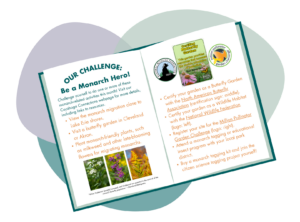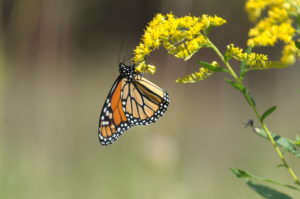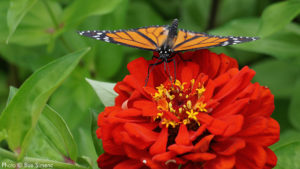Jeff Picoult
Cuyahoga Connections: Monarch Butterflies
Welcome to Cuyahoga Connections, Monarch Butterflies
This edition of the Cuyahoga Connections teaches us all about monarchs and metamorphosis. Discover the science behind the transformation from egg to flying butterfly. Learn about the seemingly unbelievable journey monarchs embark on. Test your monarch knowledge. And finally, create some super cute (and tasty) butterfly crafts of your own.
Don’t forget to reach out to us with questions, comments or to share your experiences and completed journals by sending an email to connect@forcvnp.org or tagging #forCVNP on your social media posts!
Recommended Reading
If you loved learning about monarchs and metamorphosis, we invite you to discover even more amazing creatures that call Ohio home. Exploring this board book is a great way to introduce early learners to ecological concepts.
Curious Critters Ohio introduces young readers to common backyard animals found in the Buckeye State. Fun and educational, this board book features a rabbit, frog, owl, turtle, cardinal, and more! Part of the “Look & Listen” series, Curious Critters Ohio encourages young nature lovers and their families to watch and listen for wildlife in their own backyards and other places near home.
Journal About It!
Now you’re ready to dive into the science of metamorphosis! After completing this extensive journal, you’ll be ready to become a monarch’s hero.
Send your completed journal to us connect@forcvnp.org or post photos online and tagging us #forCVNP
Download the journal here

Challenge: Be a Monarch Hero!
You can make a big difference for monarchs right here in Ohio. Challenge yourself, your family and your friends to some of these monarch-related activities:
- View the monarch migration close to Lake Erie shores and within Cuyahoga Valley National Park.
- Volunteer to study butterflies and to help restore monarch habitat within Cuyahoga Valley National Park.
- Visit a butterfly garden in Cleveland or Akron.
- Plant monarch-friendly plants, such as milkweed and other late-blooming flowers for migrating monarchs.
- Certify your garden with the North American Butterfly Association, the National Wildlife Federation, and/or the Million Pollinator Garden Challenge.
- Attend a monarch tagging or educational insect program with your local park district.
- Buy a monarch tagging kit and join the citizen science tagging project yourself!
See details below, including links with resources.
View the monarch migration close to Lake Erie shores and within Cuyahoga Valley National Park.

Jeff Picoult
Monarchs breed in Canada, then travel across Lake Erie on their way to Central Mexico. They rest on the southern shores of Lake Erie, often their first chance to land since crossing 50-60 miles over the waters. They especially like to rest near wherever milkweed and late-blooming flowers grow in order to feed on nectar. Depending on the weather, they may rest for a few hours or a few days. They are usually found from Labor Day through October. You are most likely to see them in the early morning hours before the day warms up. Look in prairie grasses or in the trees, where they may look like dead leaves with their wings closed. Here are some of the best places to view them:
-
- Wendy Park on Whisky Island (This is where the largest number were spotted in 2019)
- Cleveland Lakefront Nature Preserve
- Huntington Reservation west of Cleveland
- Euclid Beach Park east of Cleveland
- Brecksville Reservation and Acacia Reservation (especially in prairie areas)
- Wildwood Marina at Euclid Creek Reservation
- Sandy Ridge Reservation in North Ridgeville
Places to view monarchs within Cuyahoga Valley National Park as recommended Park Biologist Ryan Trimbath:
- Terra Vista has been an area of focus for butterfly habitat restoration; 14 monarchs were recorded here by our butterfly study team on Saturday, September 4, 2021!
- Indigo Lake*
- Beaver Marsh*
- Along the Towpath
- Krejci Site
- Kendall Lake*
- Armington Pond field
- Oak Hill* ; this site also has a pollinator garden within the parking lot
**You can sponsor an acre of land at sites marked with * to support the continued protection of habitats for monarchs and other wildlife!
Volunteer to study butterflies and to help restore monarch habitat within Cuyahoga Valley National Park.

NPS / Ted Toth
You can help restore butterfly habitat by volunteering for invasive plant removal, native planting, or native seed collecting drop-in events with the Conservancy. “Retired Biologist Meg Plona, who supervised the butterfly team for years, commended all the volunteers. She noted that ‘a diversity of butterfly species still exists at Terra Vista due to efforts to manage the invasive plants, especially the autumn olive’” (Restoring Butterfly Habitat at Terra Vista, nps.gov).
For more information:
- Contact the volunteer center at 330-657-2296 or email volunteer@forcvnp.org
- Visit the volunteer information website
- Check out the volunteer event calendar, which currently has “drop in” events through September 28!
Visit a butterfly garden in Cleveland or Akron.
The Cleveland Botanical Garden has a display of Central American butterflies; it is a great opportunity to learn more about the life cycle of butterflies. Stan Hywet Hall & Gardens has a temporary Butterflies of North America exhibit, open during regular days and times of operation, Tuesday through Sunday, 10 a.m.-4:30 p.m. The final date for this butterfly habitat exhibit will be Sunday, September 12.
- Return of the Butterflies » Holden Forests & Gardens (Central American butterflies)
- Butterflies of North America | Stan Hywet Hall & Gardens
Plant monarch-friendly plants, such as milkweed and other late-blooming flowers for migrating monarchs.
Planting monarch-friendly vegetation such as milkweed and essential late-blooming flowers can aid the monarchs on their migration journey. According to the Cleveland Metroparks, “White Snakeroot, Ironweed and Goldenrod are essential to the survival of the Monarch butterfly population.” Here are some local nurseries where you can buy milkweed and native flower seeds and plants:
- Ohio Native Milkweed – GROW MILKWEED PLANTS
- Common milkweed seeds
- Swamp milkweed, Asclepias incarnata seeds for sale
- Ohio Prairie Nursery sells milkweed, wildflower, and native grasses seeds: Shop Ohio Prairie Nursery | Wildflower Seed & Seed Mixes
- Avalon Gardens Inn in Chesterland
- Ohio Native Growers, Ohio’s Premier Native Nursery Directory
- Ohio Native Plant Growers list: Where to Buy Native Plants — Ohio Native Plant Month
- American Meadows: Asclepias, Milkweed, Butterfly Weed Seeds | American Meadows
Certify Your Garden

Sue Simenc
Once you have planted plenty of pollinator-friendly plants and flowers, your site may qualify to be certified as a butterfly garden, wildlife habitat, or pollinator garden with different organizations.
- In order to become a Certified Butterfly Garden with the North American Butterfly Association, your garden should have:
- “At least three different native caterpillar food plants must be grown, preferably more than one plant of each selected species. NABA encourages the use of plant species native to your area, but does not require it.”
- “At least three different native butterfly nectar sources must be grown, preferably more than one plant of each selected species. NABA encourages the use of plant species native to your area, but does not require it. “
- Pesticide-free maintenance. “The use of pesticides is discouraged. Pesticides can kill butterflies as well as other important pollinators.”
- Find out more here: Butterfly Garden Certification Program – North American Butterfly Association (nababutterfly.com)
- In order to become a Certified Wildlife Habitat with the National Wildlife Federation, you need the following elements:
- “Food: Native plants provide food eaten by a variety of wildlife. Feeders can supplement natural food sources.”
- “Water: All animals need water to survive, and some need it for bathing or breeding as well.”
- “Cover: Wildlife need places to take shelter from bad weather and places to hide from predators or hunt for prey.”
- “Places to Raise Young: Wildlife need resources to reproduce, and to protect and nourish their young.”
- “Sustainable Practices: Maintain your yard or garden in natural ways to ensure soil, air, and water stay healthy and clean.”
- Find out more here: Certify Your Habitat to Help Wildlife! – Certified Wildlife Habitat (nwf.org)
- In order to register your site for the Million Pollinator Garden Challenge, simply complete this form.
- To learn more about the challenge and find more gardening resources, visit this website: Home – Million Pollinator Garden Challenge (millionpollinatorgardens.org)
Attend a monarch tagging or educational insect program with your local park district
- Every year, the GPD Naturalist Department demonstrates monarch tagging daily at the Geauga County Fair over Labor Day weekend. Mark your calendars!
- There are two sweep-netting and monarch tagging programs on Sunday 9/12 from 12:30-4 p.m. at Orchard Hills Park and on Sunday 9/19 from 12:30-4 p.m. at Swine Creek Reservation. Naturalists will update individuals if the monarch they catch and tag is recovered along the butterfly’s migration route.
- Lake Metroparks will host their annual Bug Day celebration, featuring live bugs, games, activities, and crafts on Sunday 9/12 from Noon-4 p.m. at Penitentiary Glen Reservation.
Buy a monarch tagging kit and join the citizen science tagging project yourself!
If you are interested in contributing to the citizen science monarch tagging project, you can order your own tagging kits, report recovered butterflies with tags, and record/submit data through this website: Monarch Watch Monarch Tagging Program





